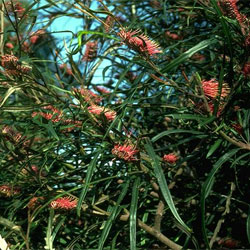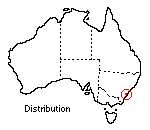Grevillea longifolia
 |
 |
Fern-leaf Grevillea
The Fern-leaf Grevillea (Grevillea longifolia) was formerly known as G. asplenifolia. Research by taxonomic botanists has applied the name Grevillea asplenifolia to the former variety, G. asplenifolia var. shepherdii and G.longifolia is recognised as a separate taxon.
 The
'toothbrush' Grevilleas to which G. longifolia belongs, form a group
of species occurring in many parts of Australia. Grevillea longifolia is mainly found within the Blue Mountains region of New South Wales, growing
naturally along the banks of creeks and gullies. Here it develops into a large,
spreading shrub with long sawtooth leaves and red toothbrush flowers.
The
'toothbrush' Grevilleas to which G. longifolia belongs, form a group
of species occurring in many parts of Australia. Grevillea longifolia is mainly found within the Blue Mountains region of New South Wales, growing
naturally along the banks of creeks and gullies. Here it develops into a large,
spreading shrub with long sawtooth leaves and red toothbrush flowers.
Grevilleas belong to the Proteaceae, a family which shows great diversity of form. The members of this family contain some of the most colourful species of Australian plants, cultivated for their striking forms and their ability to attract birds.
In the Australian National Botanic Gardens this species has proven itself to be very reliable and hardy, growing to a height of 2.5 - 3 m with a spread of 5 - 6 m. Given a sunny well-drained position with a bi-yearly application of blood and bone, it easily reaches a height and spread of 2 x 4 m in four years.
Pinkish-red flowers cover the sweeping branches from spring through to summer. The individual flowers are arranged in one-sided racemes 4 - 8 cm long. The linear leaves have a slight rust-red tinge when young and their undersurfaces are covered with flat, silky brownish hairs. These serrated or rarely entire leaves are 12 - 28 cm long, 13 - 23 mm wide, with the serrations usually reaching halfway to the midrib. The fruit is a thin-walled follicle which quickly turns brown and opens so to collect the two seeds which each follicle contains, one must keep a close eye on them or cover the fruits with a bag.
Propagation from seed is not recommended as the species hybridises readily with other Grevillea species. The progeny will thus be of uncertain type unless seed is collected from a natural source.
G. longifolia benefits from pruning after it has flowered, but it will also withstand hard pruning if the plant becomes very lanky. Propagation from cuttings is easily carried out. Tip cuttings of new season's growth taken in December or January will give the best results. Reasonable results are also obtained from cuttings taken during the other months of the year. Cuttings 12 - 20 cm long are ideal and take an average of four to eight weeks to strike. This species has also proven itself resistant to insect and disease attack including root-rot fungus.
Text by ANBG staff (1975)
Name meaning: Grevillea longifoliaGrevillea - after C. F. Greville, an 18th century patron of botany and President of the Royal Society of London; longifolia - a Latin compound from longus, 'long', and folius, 'leaved' |
![An Australian Government Initiative [logo]](/images/austgovt_brown_90px.gif)

